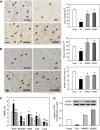Health Span-Extending Activity of Human Amniotic Membrane- and Adipose Tissue-Derived Stem Cells in F344 Rats
- PMID: 26315571
- PMCID: PMC4572897
- DOI: 10.5966/sctm.2015-0011
Health Span-Extending Activity of Human Amniotic Membrane- and Adipose Tissue-Derived Stem Cells in F344 Rats
Abstract
Aging brings about the progressive decline in cognitive function and physical activity, along with losses of stem cell population and function. Although transplantation of muscle-derived stem/progenitor cells extended the health span and life span of progeria mice, such effects in normal animals were not confirmed. Human amniotic membrane-derived mesenchymal stem cells (AMMSCs) or adipose tissue-derived mesenchymal stem cells (ADMSCs) (1×10(6) cells per rat) were intravenously transplanted to 10-month-old male F344 rats once a month throughout their lives. Transplantation of AMMSCs and ADMSCs improved cognitive and physical functions of naturally aging rats, extending life span by 23.4% and 31.3%, respectively. The stem cell therapy increased the concentration of acetylcholine and recovered neurotrophic factors in the brain and muscles, leading to restoration of microtubule-associated protein 2, cholinergic and dopaminergic nervous systems, microvessels, muscle mass, and antioxidative capacity. The results indicate that repeated transplantation of AMMSCs and ADMSCs elongate both health span and life span, which could be a starting point for antiaging or rejuvenation effects of allogeneic or autologous stem cells with minimum immune rejection.
Significance: This study demonstrates that repeated treatment with stem cells in normal animals has antiaging potential, extending health span and life span. Because antiaging and prolonged life span are issues currently of interest, these results are significant for readers and investigators.
Keywords: Adipose tissue-derived mesenchymal stem cell; Amniotic membrane-derived mesenchymal stem cell; Cognitive function; Health span; Life span; Physical activity.
©AlphaMed Press.
Figures






References
-
- Kirkwood TB. Understanding the odd science of aging. Cell. 2005;120:437–447. - PubMed
-
- Lapchak PA, Miller PJ, Jiao S. Glial cell line-derived neurotrophic factor induces the dopaminergic and cholinergic phenotype and increases locomotor activity in aged Fischer 344 rats. Neuroscience. 1997;77:745–752. - PubMed
-
- Volkow ND, Gur RC, Wang GJ, et al. Association between decline in brain dopamine activity with age and cognitive and motor impairment in healthy individuals. Am J Psychiatry. 1998;155:344–349. - PubMed
-
- Finkel T, Holbrook NJ. Oxidants, oxidative stress and the biology of ageing. Nature. 2000;408:239–247. - PubMed
-
- Ito K, Hirao A, Arai F, et al. Reactive oxygen species act through p38 MAPK to limit the lifespan of hematopoietic stem cells. Nat Med. 2006;12:446–451. - PubMed
Publication types
MeSH terms
Substances
LinkOut - more resources
Full Text Sources
Other Literature Sources
Medical
Molecular Biology Databases

